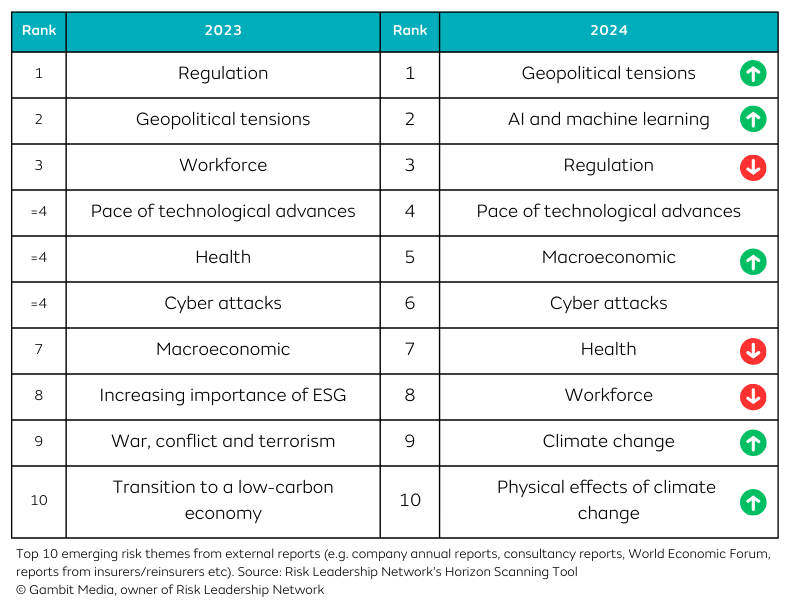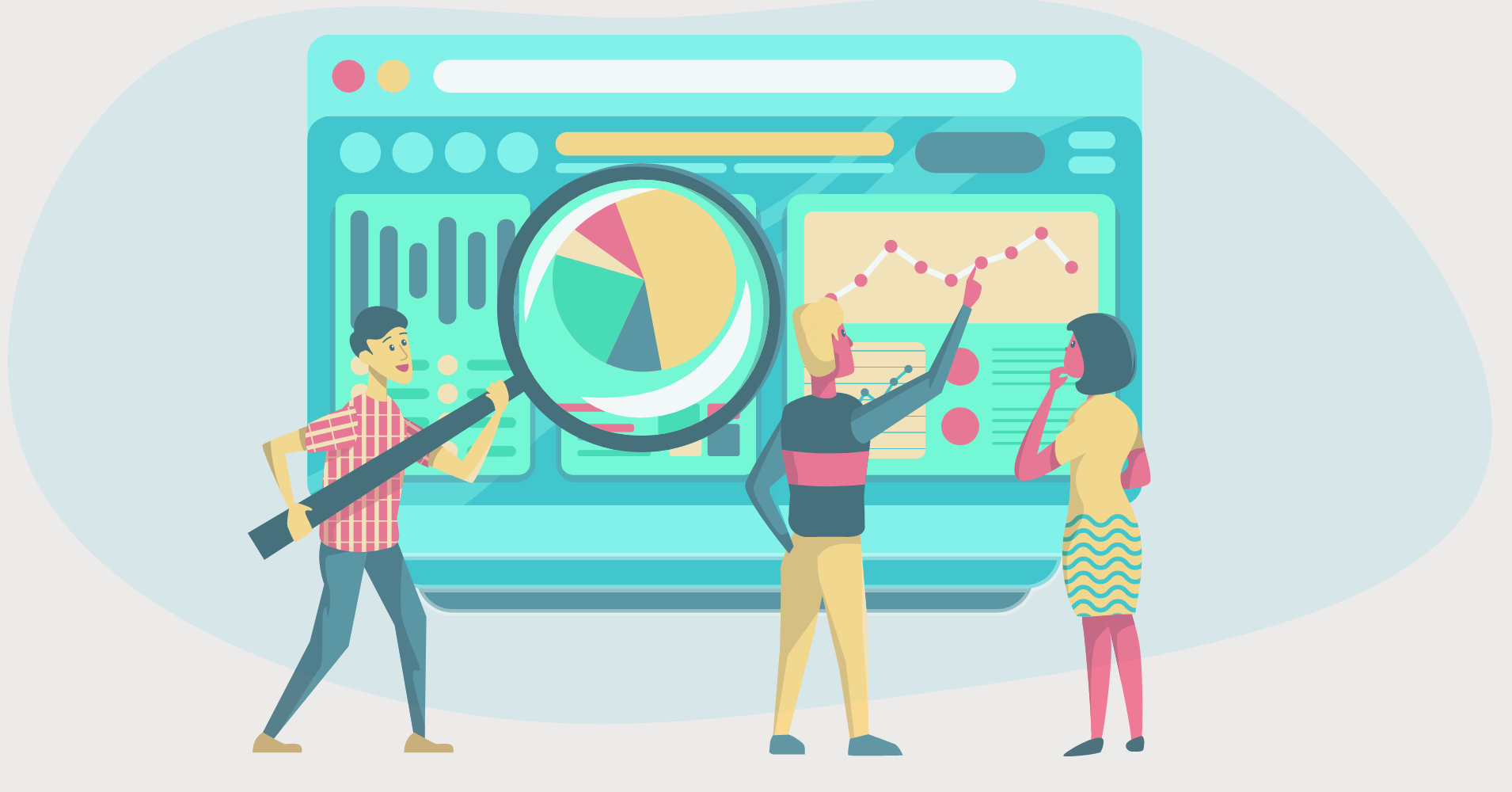Across all sectors, companies are working hard to effectively identify and monitor their emerging risks, ensuring that they're managing any potential blind spots. Our members tell us that having an external lens to support and validate their horizon scanning is vital.

Top emerging risk categories 2024 vs 2023


1. Geopolitical tensions causing uncertainty
"Geopolitical tensions" has quickly developed into one of the top emerging risk trends over the past three years and was mentioned more frequently in annual reports than any other emerging risk in 2024.
|
Examples of risks include:
|
2. The rise of artificial intelligence and machine learning
Increasing accessibility and implementation of artificial intelligence (AI) — particularly generative AI tools like ChatGPT — has made this technological development a key emerging risk trend in the past year.
Interestingly, "AI and machine learning" was not even ranked in the top 10 emerging risk trends in 2022 or 2023, demonstrating how quickly it has risen up the agenda of companies in the last year.
Organisations are highlighting both the threats and opportunities of this technology in their annual reports, noting its "transformative impact". While the automation of specific processes using AI tools could deliver some efficiencies and even "disrupt" industries, some companies point out the threat of "weaponised AI", which may increase the sophistication of cyber threats and make the business more vulnerable.
The other big risk for companies is a failure to adopt AI-based mechanisms at the same pace as their competitors, which may become a key driver of implementation over the next few years.
|
Examples of risks include:
|
3. Regulation remains in focus
|
Examples of risks include:
|
Horizon Scanning ToolThe data in this article comes from Risk Leadership Network's Horizon Scanning Tool. Created for: Risk Leadership Network members who wanted to save time sense-checking and validating their emerging risk reporting. Data included: Data and trends on the emerging risks included in company annual reports (FTSE 100, S&P 500 and ASX 20-listed companies, plus others requested by members) as well as reports from the World Economic Forum, insurers/reinsurers and consultancies. Used to: Save time collating external data on emerging risk, validate your approach, and identify blind spots. Accessible by: An interactive database, available as one of the many bespoke resources created for Risk Leadership Network members. Get sector trends: Filter by sector or region to identify the trends most relevant to you. Find out more with the information on this page, which includes the option to book a demo. |
4. Pace of technological advances increasing
While the increased adoption of AI and machine learning, highlighted above, is one dimension of technological development, there are many other elements companies are focusing on.
For example, a number of organisations have highlighted "quantum computing" in the emerging risk section of their reporting, suggesting this could present a threat to how businesses protect sensitive information.
On the other hand, this technology has the potential to uplift forecasting, which could have a beneficial impact.
As the pace of technological development continues to move up the curve, there also needs to be an awareness of competing requirements. This includes maintaining the trust of customers regarding data privacy, ensuring transparency on data ethics practices and preparing for any disruption caused by technology adoption.

5. Inflation and cost-of-living driving macroeconomic risk
Another key trend from 2024, "macroeconomic" risks — driven by a range of factors — are also in focus for organisations.
A number of companies, for instance, have mentioned the impact of cost-of-living crises around the world, but particularly in the UK. With food, fuel and energy prices remaining high as a result of inflation, this will naturally impact customers' ability to spend, presenting a financial risk to companies.
Other organisations noted the rise in interest rates and suggested this may affect M&A activity and wider financial conditions
What areas of emerging risk are your peers prioritising in 2025?Creating the Horizon Scanning Tool is one example of a bespoke solution we've provided for a member/members to support them with a specific priority. As we go into 2025, we're facilitating targeted peer-to-peer collaboration on the following emerging risk priorities:
To find out more about these collaborations, request a 15-minute discovery call or find out more about membership. |
Looking ahead - supporting risk leaders on emerging risk
Providing an external lens for horizon scanning is one of the many ways that we're supporting our member organisations as they introduce, enhance and adapt their emerging risk frameworks. We're currently facilitating peer collaboration to support individual member organisations with the following challenges:
- Running emerging risk sessions with the board — how to integrate emerging risk with strategy and drive greater engagement with the board.
- Practical implementation of scenario analysis — to ensure that the business is prepared for anything that might happen.
- Benchmarking emerging risk in the energy sector — to understand sector trends and identify potential blind spots.
- Embedding an emerging risk framework — how to build conversations in the business and make it work.
Get in touch with our insights team to find out more about these collaborations and how you can get involved.
As for AI — will this trend become a principal risk for businesses in the next 12 months, or stay on most companies' emerging risk registers? And how will risk leaders support their organisations to exploit the opportunities and manage the threats that AI presents? Please contact our team to discuss the many collaborations that we're currently facilitating on AI and machine learning.
Share this
Related posts you may be interested in

Top 10 emerging risks of 2023

Introducing our new Horizon Scanning Tool

-1.gif?width=520&height=390&name=HST%20blog%20(4)-1.gif)